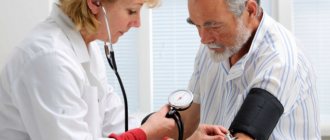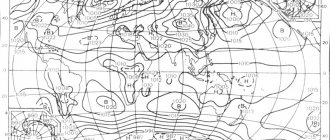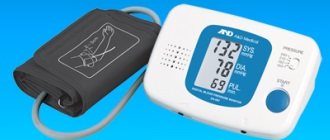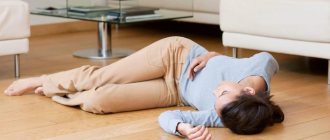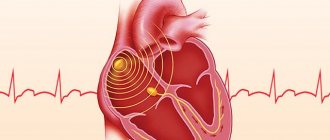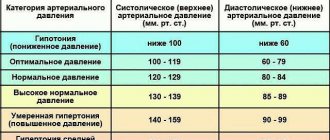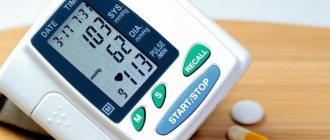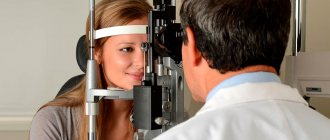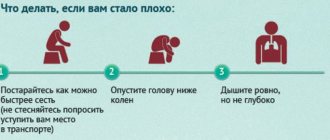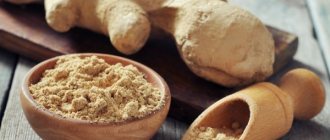Why is low blood pressure in an elderly person no less dangerous than high blood pressure?
Both conditions are dangerous - hypotension and hypertension. Doctors cannot give a definite answer as to whether high blood pressure or low blood pressure is worse. For a long time, there was an opinion that only high blood pressure is dangerous, since it puts a serious strain on the heart and this negatively affects its functioning. That is why older people with hypertension are often diagnosed with cardiovascular diseases, and they often suffer from strokes, heart attacks and other complications.
However, very low blood pressure in an elderly person is no less dangerous - with a lack of oxygen, the brain, heart, kidneys, and gastrointestinal tract cannot function normally. The result is the gradual death of organ cells.
Complications of hypotension include:
- Injuries sustained by older people during fainting conditions. They are often very strong.
- Ischemic stroke. It becomes a consequence of chronic lack of blood supply.
- Cardiogenic shock, myocardial infarction. Occurs when there is insufficient blood supply to the heart.
- Senile dementia (dementia). Develops as a result of a disturbance in the thought process due to frequent changes in blood pressure.
- Loss of sensation in limbs in older people. It becomes a consequence of disruptions occurring in the venous and arterial blood supply.
Hypotension that lasts for a long time can cause severe arterial hypertension.
We recommend
“Vitamins for elderly people over 70: which ones are needed first” Read more
Monitoring and correction of blood pressure
Optimal and normal blood pressure does not require constant monitoring. For people with such blood pressure indicators, it is enough to measure it periodically, during routine medical examinations, medical examinations, and visits to the doctor for other reasons.
High normal blood pressure (HNBP) is not an independent disease or risk factor, but is considered as a condition in which early primary prevention of arterial hypertension and associated complications is possible. The maximum predisposition to high normal blood pressure is found in men aged 40 to 59 years with a high body mass index. They are advised to control blood pressure somewhat more often than standard recommendations, get rid of bad habits, and normalize weight.
Arterial hypertension of the 1st degree is often asymptomatic and remains undetected for a long time. If its signs are accidentally detected, for example, during a routine examination, the patient is recommended to undergo 24-hour blood pressure monitoring in order to exclude the “white coat” syndrome – increased blood pressure due to anxiety and fear of doctors. When the diagnosis is confirmed, the patient needs regular observation by a local doctor and periodic self-measurement of blood pressure. Arterial hypertension of the 1st degree does not always require pharmacological therapy. Often, lifestyle adjustments help stabilize blood pressure: proper nutrition and normalization of weight, giving up bad habits, moderate physical activity, and lack of stress.
In case of arterial hypertension of 2 and 3 degrees, isolated systolic hypertension, constant (most often daily) independent monitoring of blood pressure is required. To correct these conditions, in addition to lifestyle changes, drug therapy is required, which is carried out only as prescribed and under the supervision of a doctor.
Causes of low blood pressure in older people
Low blood pressure in older people can be either a primary, underlying disease or a symptomatic consequence of other diseases. Primary hypotension is called when this condition is not accompanied by other diseases. Otherwise, we are talking about symptomatic hypotension.
Many people are interested in why low blood pressure occurs in an elderly person, what is the cause of this condition. It is difficult to figure out what to do when diastolic pressure is low. The causes in older people directly depend on the type of hypotension. The acute form is a consequence of heart attacks, blood loss, intracardiac blockade, severe arrhythmia, and an allergic reaction. In case of acute hypotension, it is important to provide first aid to the person in a timely manner.
Primary hypotension is an independent disease manifested in the form of neurocirculatory asthenia.
Physiological hypotension is a hereditary disease; in other words, it is the body’s predisposition to low blood pressure. An elderly person is already accustomed to this condition, and since the readings are not much lower than normal, they are practically the norm for low blood pressure in older people.
The main reason for low blood pressure in an elderly person is prolonged psycho-emotional stress, which gives rise to neurosis of the vasomotor centers of the brain. Severe stress, in which a person is under for a long time, causes a drop in pressure, and, as a result, primary hypotension. It is also possible that this disease may develop due to an overdose of medications for hypertension. Another cause of hypotension is a lack of vitamins B5, C, E.
Causes of primary hypotension:
- frequent neuroses;
- psychotrauma;
- chronic lack of sleep and fatigue;
- depressive states of a person and apathy towards everything.
Causes of symptomatic hypotension:
- stomach ulcer;
- arrhythmia;
- rheumatism;
- anemia;
- cervical osteochondrosis;
- problems with blood circulation;
- heart failure;
- hepatitis, etc.
We recommend
“First aid for the elderly: what you need to know about it” Read more
Possible consequences
To accurately determine all the complications and consequences of such pressure, all symptoms and influencing factors should be taken into account. To do this, the cardiologist will prescribe all the necessary diagnostics.
Particular attention is paid to this:
- Intensity of symptoms (if they pass quickly or are mild, then the condition does not pose any danger).
- Rapid onset of symptoms (when they appear suddenly and go away with difficulty, then you should immediately consult a doctor).
- History (all diseases that preceded this condition should be studied).
In addition, circulatory disorders, hypotension, hypertension, stroke, anemia and oxygen starvation of the brain may develop. And this is dangerous for human life.
Critical low blood pressure in an elderly person: first aid
Low diastolic pressure in older people is a dangerous condition, so the first thing to do is call an ambulance. While waiting for medical workers, if the patient has already lost consciousness or it seems that this may happen to him, it is necessary to provide assistance independently, in particular:
- put the elderly person on his back;
- open a window to provide access to fresh air;
- unbutton the shirt collar to free the chest area and neck from clothing;
- if the person is conscious, give him drops for hypotension;
- do a rubbing massage in the direction from the ankles up.
Medicine that is recommended for low blood pressure in older people is not always at hand, so you can use improvised means - give the person strong coffee, give 2 tablets of caffeine-containing citramon. But you should definitely check whether the patient with low blood pressure has heart disease and whether he can use blood thinning medications.
You can help a person in such a situation and slightly increase blood pressure by using acupuncture. Find a point under your nose, press it with your finger, hold for a minute, release and repeat similar manipulations 5 to 10 times. Another way is to raise a person’s legs above his head, for example, by throwing them over the headboard of a bed or sofa, placing high pillows under his feet, etc. All this can be done while waiting for the doctors to arrive. Doing this will help prevent loss of consciousness due to low blood pressure and potential injuries from falling.
We recommend
“Caring for the elderly in Russia and abroad” Read more
Symptoms
People with a lower blood pressure value of 45 are accompanied by regular fatigue, lethargy, and aggressiveness. Dizziness is common. What do you do if your blood pressure is 100/45 if you have these symptoms?
You should consult a doctor immediately. The main symptoms are listed above. Additional ones include:
- pain in the head (dull or throbbing, localized in the back of the head or temples);
- cold extremities (arms and legs);
- lack of concentration on anything;
- bad memory;
- constant desire to sleep during the day;
- inability to sleep at night;
- lack of desire for anything;
- weather dependence;
- loss of consciousness;
- inability to ride in vehicles due to motion sickness;
- regular nausea leading to vomiting;
- numbness of hands and feet;
- problems with heartbeat (too low or very high);
- chest pain;
- lack of air.
If at least a few symptoms are present, then we can talk about a pathological condition, and if the numbers are 100 to 50, we can talk about the appearance of hypotension. What to do if the pressure is 100 to 40 or 45 - next.
The manifestation and nature of symptoms with low blood pressure are individual. They depend directly on the physiological characteristics of the body, age, external and internal factors. Most often, hypotension is accompanied by the following manifestations:
- mood lability;
- darkening in the eyes and flashing “spots” before the eyes;
- nausea, vomiting;
- memory deterioration;
- occipital or temporal pain of a pulsating nature;
- dizziness and even short-term loss of consciousness;
- general weakness and feeling of chronic fatigue;
- cold extremities;
- tachycardia;
- coldness and numbness of the extremities;
- cognitive impairment;
- decreased performance;
- drowsiness;
- weather dependence.
A decrease in blood pressure causes a feeling of weakness and fatigue.
Symptoms, their intensity, frequency of occurrence and tolerability vary from person to person. They depend on the physiological characteristics of a person, his age, the cause of hypotension, external factors and other reasons. The most common symptoms of low blood pressure:
- darkening of the eyes;
- mood swings;
- nausea;
- depression;
- memory impairment;
- lack of air;
- throbbing, monotonous pain in the back of the head, temples, forehead;
- low concentration;
- weakness;
- vomit;
- chills of extremities;
- tachycardia;
- fast fatiguability;
- loss of consciousness;
- numbness of the limbs;
- acclimatization;
- chronic fatigue;
- low performance;
- dizziness;
- heaviness in the chest area;
- constant drowsiness;
- weather sensitivity;
- absent-mindedness.
How to increase low blood pressure in an elderly person at home
If your blood pressure suddenly drops, but the readings are not critical, do not panic. We will tell you how to increase low blood pressure in an elderly person at home.
- One of the simplest and most widely known ways to increase blood pressure is to drink strong coffee. Caffeine helps dilate blood vessels and helps give the body a boost of energy. The drink helps especially well those older people who drink it rarely, about once a week. For those who drink coffee every day, it will be more difficult, because... It will not be possible to obtain the desired effect with low blood pressure if the body is already accustomed to caffeine.
- Strong sweet tea will help raise blood pressure and tone the body.
- Regular salt will come to the rescue. By eating something salty or even just putting a little salt on the tongue, an elderly person can alleviate his condition.
- Honey combined with cinnamon is considered one of the fastest ways to increase low blood pressure, and the effect remains for a long period. Take half a teaspoon of cinnamon and dissolve it in a glass of boiling water, add one spoon of honey. Wait half an hour for the drink to infuse, after which you can drink it. Or you can make it simpler: spread honey on a piece of bread, sprinkle cinnamon on top and eat this sandwich.
- You can eat something fatty, of course, it is better not to eat fatty foods too often, but if there is no other way to cope with a sharp drop in blood pressure, then you can use this one.
- Consuming glucose or refined sugar will also help raise your blood pressure. Glucose is sold in pharmacies in tablets.
- Cognac or red wine, but it is important to know the limit - no more than 50 grams per day. Usually cognac is added to coffee or tea.
We recommend
“Service for the elderly: forms, types and features” Read more
Pulse
When the pressure is 100 over 50 and the pulse is 100, medical intervention is necessary, since such conditions pose a danger to human health and life.
You should not hesitate if the following signs are present:
- With severe or moderate blood loss;
- With sepsis, severe weakness, fever and grayness of the skin are observed;
- Anaphylactic shock is often accompanied by angioedema and can be fatal;
- With inflammation of the lungs, heat, pain;
- For heat stroke, nausea, vomiting;
- When a cerebral hemorrhage occurs, severe pain, vomiting, convulsions, and loss of consciousness are felt.
Pulse indicators with hypotension are very variable.
A pulse of 60 to 90 beats per minute is considered normal if it is combined with chronic hypotension, then in this case low blood pressure is not considered an indication for hospitalization, however, in some cases additional examinations are required to exclude certain pathologies.
A slight increase in pulse readings with arterial hypotonicity is also normal, as this is a compensatory reaction of the body to a decrease in blood pressure. This is how the body provides vital organs with oxygen and nutrients, since without them existence is impossible.
The combination of low blood pressure and a drop in heart rate may result from:
- high-grade blood loss;
- septic condition;
- anaphylaxis;
- states of shock;
- heat stroke;
- hemorrhages in brain tissue.
A slow heart rate with hypotension can be caused by:
- congenital characteristics;
- hypothermia;
- atherosclerosis;
- myocardial infarction;
- pericarditis;
- myocarditis;
- endocarditis;
- oncopathology;
- traumatic brain injuries;
- intoxication of the body.
Traditional medications for hypotension
We have already figured out what low blood pressure means in an elderly person. This is a serious illness, and it is often impossible to cope with it using only home methods, because... the use of special medications that normalize blood pressure is required. Caffeine remains the most popular remedy for hypotension.
But besides it, other groups of drugs are also used:
- Psychomotor stimulants.
They help an elderly person cope with weakness and chronic fatigue syndrome. Thanks to stimulants, the hypotensive person becomes functional, lethargy and drowsiness disappear, and the normal state is normalized. The most popular drugs from this medicinal group: Sydnofen, Mesocarb, Sydnocarb, etc.
- Analeptic drugs
Improves the functioning of the cardiovascular system and respiratory organs. After using them, older people with low blood pressure begin to feel better, their overall tone and mood improve. This group includes the following drugs: Cordiamine, Centedrin and similar ones.
- Adrenomimetic drugs
These drugs are necessary to increase both diastolic and systolic pressure, so their use is justified only in very difficult cases. They are designed to ensure normal blood circulation. These are Regulton, Gutron, Fethanol, etc.
- Nootropics
This group of products is intended to optimize metabolic processes in the central nervous system and normalize blood circulation. Thanks to taking such medications, an elderly person’s memory improves and the learning process is facilitated. Phenibut, Pantogam, Piracetam, Aminalon, etc. are considered effective nootropic drugs.
We must not forget about the need to take complex vitamin preparations, especially if we are talking about an exacerbation of the disease.
If drug treatment for low blood pressure in older people is carried out at home, it is necessary to strictly adhere to the dosage prescribed by the doctor. If your condition worsens after taking medications, then immediately contact a specialist to adjust treatment taking into account the characteristics of the course of the disease in each individual case.
We recommend
“Nutrition for the elderly: basic principles and rules” Read more
Normal heart rate with blood pressure 100/50
Heart rate is a very important sign when diagnosing any condition. Usually, with hypotension, blood pressure is compensated by a rapid pulse; this is a feature of the human body, but this phenomenon cannot always be observed, and the heartbeat does not go out of the norm. This feature suggests that for this individual the state of hypotension is normal.
Important! A pressure of 100 over 50 in some cases indicates a heart defect, and full diagnostic measures such as ultrasound of the heart and ECG are necessary here.
Traditional methods of dealing with low blood pressure
There are many traditional ways to combat low blood pressure, but we must not forget that different people may react to them differently.
- Immortelle decoction
To prepare it, take a tablespoon of immortelle flowers, pour boiling water (250 ml) and keep in a water bath for 15 minutes. After this, you can strain the broth and take it. This amount of ingredients is calculated for the daily dose. The effect can be obtained if you drink the decoction three times a day - 1/3 cup before each meal.
- St. John's wort decoction
It is advisable to consult a specialist before taking St. John's wort decoction for low blood pressure. The recommended daily dose of the decoction is no more than 250 ml, and it must be adhered to. The course of treatment is no more than a month; a decoction is prepared by analogy with immortelle decoction.
- Infusion of calamus, burdock, chicory
This infusion is prepared from the roots of burdock, chicory and calamus. 100 grams of each ingredient are crushed and mixed, poured into a liter jar, which is then filled with water to the brim. The jar should be placed in a dark place for 10 days. After the specified period, take the infusion 5 drops, dissolving them in a tablespoon of water. The infusion is drunk three times a day for three weeks.
- Grape or pomegranate juice
Grape or pomegranate juice can do an excellent job of increasing blood pressure. Of course, the best effect will come from fresh; store-bought will not work, since it is canned. Buy dark grapes, squeeze the juice out of them, preferably before eating. Dosage – half a glass twice a day, course of administration – two weeks. Pomegranate juice will help cope with dizziness and headaches.
We recommend
“Boarding house for the elderly: 11 myths about the life of old people” Read more
conclusions
With this pressure value - 110/50 (you already know what this means), you need to be wary, since such blood pressure indicators can be both normal and pathological.
It is quite easy to distinguish whether this is normal or not. With this problem (namely: what does pressure 100/55 mean), you just need to listen to yourself and your well-being.
If there are side factors - fever, vomiting, nausea (or pressure appeared due to injury), then you should urgently consult a therapist.
Prevention of hypotension in the elderly
To prevent the development of hypotension and related diseases, older people should follow a number of recommendations:
- Try not to overwork and avoid stress.
- Drink 1.5 to 2 liters of liquid per day.
- Be active and mobile.
- Take frequent walks in the fresh air.
- Eat more herbs, spices and salt.
- Do general strengthening exercises.
- Limit hot baths, replacing them with contrast showers.
- Reduce the amount of carbohydrates in food to prevent surges in blood pressure and blood sugar.
